Facial aesthetics plays a very important role in dentistry. Loss of teeth leads to the resorption of alveolar ridges, loss of support to the facial musculature resulting in diminished facial muscle tone, all of which lead to the slumping of the cheek. Authors here by present a case of a 59-year-old male patient who reported with the complaint of missing upper and lower teeth. Intraoral examination revealed completely edentulous maxillary and mandibular arches. Extraoral examination revealed sunken cheek and wrinkling of the skin. The patient was more concerned about his hollow cheek, so the treatment option advised for him was complete denture with detachable cheek plumpers. The technique used here precisely determines available space for cheek plumpers. But, despite of providing the maxillary cheek plumper, appearance of hollow cheek remained in lower third of face. So, the mandibular cheek plumper was also planned. This case report a novel, simple, straightforward, cost-effective and noninvasive technique of fabricating detachable cheek plumpers for maxillary and mandibular denture using customised ball attachment.
Case Report
A 59-year-old male patient reported to the Department of Prosthodontics complaining of missing upper and lower teeth. The reason for the loss of teeth was mobility and had been edentulous for the last three years. Patient had poor aesthetic and wanted to improve his overall facial appearance. Intraoral examination revealed completely edentulous maxillary and mandibular arches with high well rounded ridges. On extraoral examination revealed sunken cheek and wrinkling of the skin [Table/Fig-1]. Because the patient was more concerned about his hollow cheek and considering his economic condition, the treatment option advised for him was complete denture with detachable cheek plumpers.
Patient showing sunken cheek.
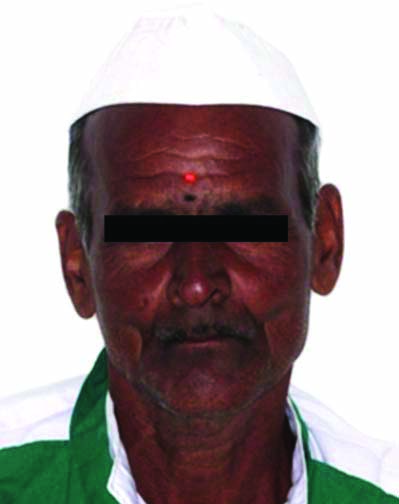
Primary impressions were made using reversible impression compound (DPI, pinnacle impression compound). Primary casts were obtained and custom trays were made with autopolymerising acrylic resin. Then the border molding was done with a green stick compound (pinnacle tracing sticks) and final impressions were made with the addition silicone light body (Aquasil, Dentsply). Face bow transfer was made and jaw relation was recorded. At the time of try-in appointment, a roll of the softened green stick was adapted over the buccal flanges of a maxillary denture in the premolar-molar region and asked the patient to do the various movements like pouting, whistling, smiling, licking, sucking, pursing of lips, phonetics, water sipping and swallowing so that green stick patterns were well adapted in physiologic spaces and hence, it would not interfere with the functions.
An extraoral evaluation was done for cheek fullness and it was observed that only maxillary cheek plumpers were insufficient to provide cheek support so that mandibular cheek plumpers were planned [Table/Fig-2]. The above steps were repeated for mandibular denture until the cheek got required fullness and careful examination was done to ensure that plumpers had not created any occlusal interference. Then, the patient’s consent was obtained for facial appearance and the denture, cheek plumper were processed separately using heat polymerised acrylic resin. Plumper attachments were made by the following method:
Trial dentures with green stick patterns for cheek plumpers (a) maxillary and (b) mandibular.

Plastic beads (2-3 mm diameter) were attached to the 5-6 mm thickness of roughly squared shaped patterns which were cut in beading wax. These patterns were cast in a cobalt-chromium alloy. Completed castings were polished. For retention, orthodontic separators were used [Table/Fig-3].
Fabrication of customised ball attachment.
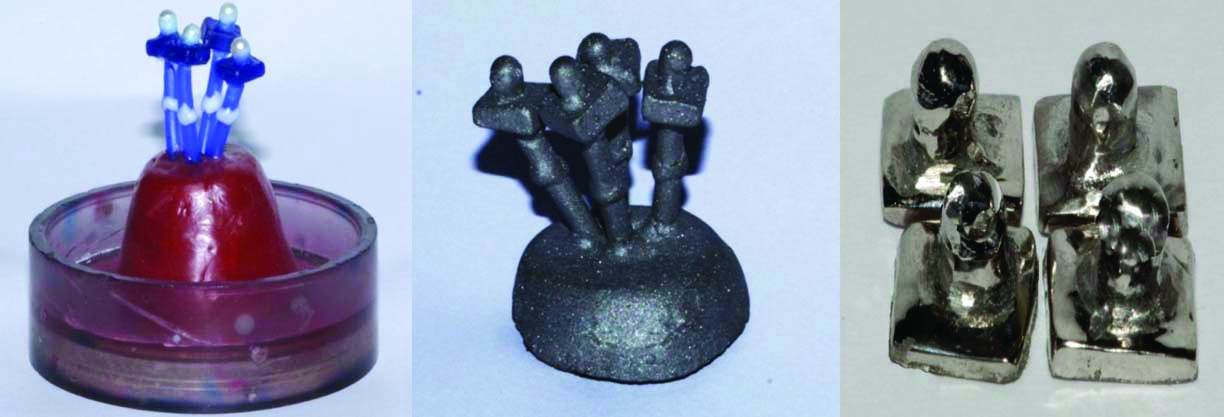
Now, the orthodontic separators were incorporated into the dentures in premolar molar region and ball attachments were picked-up by the plumper using autopolymerising acrylic resin by creating the trough in the plumper [Table/Fig-4,5] to achieve the good fit [Table/Fig-6,7]. After that, denture insertion was done. The facial appearance was evaluated to avoid tense appearance [Table/Fig-8,9]. Postdenture instructions given to the patient were cleaning of denture and plumpers with water and denture brush after every meal and advised to store the denture in water or dilute antiseptic solution. Patient was trained for insertion and removal of the denture with plumpers. Follow-up was scheduled after 24 hours, 48 hours, and thereby every after three months and checked for occlusion, denture extension, comfort of the patient and tissue reaction. Patient was comfortable and satisfied for improved outcome.
Maxillary and mandibular complete denture with detachable plumpers.

Surface view of attachment.

Intraoral view of molar relationship.

Intraoral view of cheek plumpers.
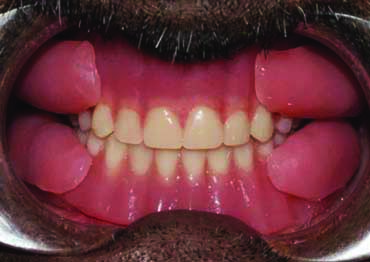
a) Pre-operative; b) postoperative view.
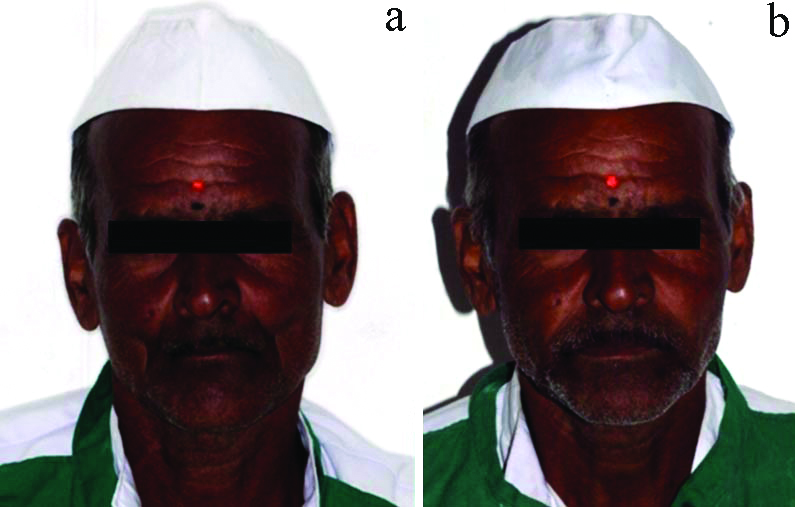
Postoperative view while smiling.
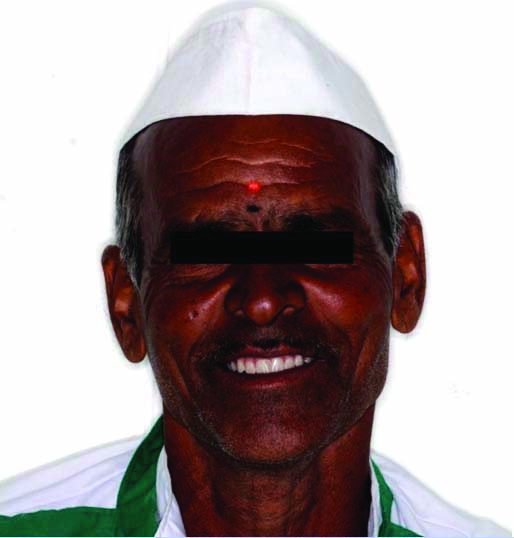
Discussion
Jamieson CN stated, “Fitting the personality of the aged patient is often more difficult than fitting the denture to the mouth” [1]. Completely edentulous patients always demand improved aesthetic appearance at the end of the treatment. As age progresses a lot of changes in facial structure takes place. Edentulism is associated with the loss of the tooth, resorption of residual alveolar ridges, reduced muscle tone, tissue laxity resulting in the hollowing of a cheek, leading to sunken appearance. In addition, an increase in age leads to thinning of the upper lip, drooping of the corner of the mouth, deepening of nasolabial groove, hollowing of the cheek, and flattening of the philtrum is also seen, which produces a sagging look. Thus, the resulting sunken or slumped cheeks can add years to a person’s age and it has a major impact on persons professional and social life as well as self-confidence and psychology of patient [2,3].
Because the cheek is one of the prominent structure of the face which has a major role in enhancing the facial appearance, these age changes do not only affect mastication but aesthetics is also compromised, especially seen on the lower third of the face. Also, as the age increases, there is an increase in wrinkling of the skin, loss of subcutaneous fat and elasticity of the tissue below the malar bone causes the cheeks to become slumped [4]. However, properly contoured labial and buccal flange extension does support the facial tissue but sometime it may require additional support near premolar and molar region [5]. In such situations, a cheek plumper can be advised.
Cheek plumper or cheek lifting appliances have known to be a prosthetic option to enhance the aesthetics in edentulous patients, facial paralysis, and maxillofacial defect [6,7]. Cheek plumper is of two types [8]:
Undetachable/Conventional cheek plumper
Detachable cheek plumper
Undetachable cheek plumpers are no longer used now-a-days because of increased width and length leads to less maxillary complete denture retention, difficulty in insertion, muscle fatigue, unable to use in the atrophic mouth and cannot be effectively clean [9]. Opposite to that detachable cheek plumpers are easy to place and remove, easy to clean.
Sometimes, the maxillary detachable cheek plumpers do not provide adequate support to the facial musculature and require additional support in the mandibular jaw near the angle of the mouth, then the mandibular cheek plumpers can be added to fill the inadequacy and restore the lost facial contour [10].
This case report illustrates the effective and efficient method for the fabrication of detachable maxillary and mandibular cheek plumper with customised attachment to enhance facial aesthetics. The presented case is the modification of the technique proposed by Keni NN et al., [5]. The ball attachment had been made of plastic beads and subsequently cast into a cobalt-chromium alloy. The CO-CR alloy is readily available in a dental laboratory thus the overall cost of the attachment is reduced. It has a property of biocompatibility, corrosion resistance [11-13] and, reported less number of allergies [14,15]. Also, these customised attachments were incorporated on the inner surface plumper, so that, it has added advantages like, whenever the patient removes the plumper, it will not cause any irritation to the cheek and orthodontic elastics will not be visible while doing the functional activity.
Various attachments have been well documented to secure the plumper with the denture. Verma N et al., Venkatachalapathy SR et al., Shah RJ et al., used a magnet [9,16,17], while Aggarwal P et al., Virdiya NM et al., Bharathi BM et al., used press button [8,10,18]. Similar to presented case, Rodrigues MT et al., proposed precision ball attachment [19], Bhushan P et al., used friction lock attachment for the retentive mechanism [20]. The magnet has the benefit of being small, automatic reseating because of magnetic force, easy to place, remove and easy to clean. Perhaps they have poor corrosion resistance and loss of magnetic property over time [21,22]. NdFeB magnet produces a close magnetic field which should be used cautiously in pacemaker patients [23]. Press button attachments and friction lock attachments are difficult to clean and after a certain period, they might get break. However, there are less no. of articles available with customised attachments such as press stud fasteners [8,10], ball attachments with housings [19], friction lock retentive attachments [20], dowel pins and sleeves [24], orthodontic wire loop [25]. Some of the shortcomings of cheek plumpers are increased weight of dentures due to the bulk of plumpers which can be easily overcome by lost salt processing technique, food accumulation, and requirement of manual dexterity of patient to secure the attachment.
Conclusion(s)
The present case report gives innovative, simple, and cost-effective method for the fabrication of attachment for the retention of cheek plumper which could restore the normal contour of the face and enhance the aesthetic along with maintaining the stability of denture during various functional movements.
[1]. Jamieson CH, Geriatrics and the denture patient J Prosthet Dent 1958 8(1):08-13.10.1016/0022-3913(58)90004-0 [Google Scholar] [CrossRef]
[2]. Bains JW, Elia JP, The role of facial skeletal augmentation and dental restoration in facial rejuvenation Aesthetic Plast Surg 1994 18(3):243-46.10.1007/BF004497887976755 [Google Scholar] [CrossRef] [PubMed]
[3]. Zarb GA, Hobkirk J, Eckert S, Jacob R, Prosthodontic treatment for edentulous patients-e-book: Complete dentures and implant-supported prostheses Elsevier Health Sciences 2013 Nov 21 [Google Scholar]
[4]. Martone AL, Effects of complete dentures on facial esthetics J Prosthet Dent 1964 14(2):231-55.10.1016/0022-3913(64)90084-8 [Google Scholar] [CrossRef]
[5]. Keni NN, Aras MA, Chitre V, Customised attachments retained cheek plumper prosthesis: A case report J Indian Prosthodont Soc 2012 12(3):198-200.10.1007/s13191-012-0132-y23997472 [Google Scholar] [CrossRef] [PubMed]
[6]. Larsen SJ, Carter JF, Abrahamian HA, Prosthetic support for unilateral facial paralysis J Prosthet Dent 1976 35(2):192-201.10.1016/0022-3913(76)90279-1 [Google Scholar] [CrossRef]
[7]. Lazzari JB, Intraoral splint for support of the lip in Bell’s palsy J Prosthet Dent 1955 5(4):579-81.10.1016/0022-3913(55)90187-6 [Google Scholar] [CrossRef]
[8]. Aggarwal P, Gupta MR, Pawah S, Singh A, An innovative technique to improve complete denture aesthetics using cheek plumper appliance: A case report Int J Oral Health Med Res 2016 3:51-54. [Google Scholar]
[9]. Verma N, Chitre V, Aras M, Enhancing appearance in complete dentures using magnetic retained cheek plumpers J Indian Prosthodont Soc 2004 4(2):35-38. [Google Scholar]
[10]. Virdiya NM, Palaskar JN, Wankhade J, Joshi N, Detachable cheek plumpers with different attachments for improving esthetics in a conventional complete denture: A clinical report J Prosthet Dent 2017 117(5):592-96.10.1016/j.prosdent.2016.08.021 [Google Scholar] [CrossRef]
[11]. Khamis E, Seddik M, Corrosion evaluation of recasting non-precious dental alloys Int Dent J 1995 45(3):209-17. [Google Scholar]
[12]. Geis-Gerstorfer J, Sauer KH, Pässler K, Ion release from Ni-Cr-Mo and Co-Cr-Mo casting alloys International Journal of Prosthodontics 1991 4(2):152-58. [Google Scholar]
[13]. Brune D, Metal release from dental biomaterials Biomaterials 1986 7(3):163-75.10.1016/0142-9612(86)90097-9 [Google Scholar] [CrossRef]
[14]. Wiltshire WA, Ferreira MR, Ligthelm AJ, Allergies to dental materials Quintessence Int 1996 27(8):513-20. [Google Scholar]
[15]. Takeda T, Shigami K, Shimada A, Ohki K, A study of discoloration of the gingiva by artificial crowns Int J Prosthodont 1996 9(2):197-202. [Google Scholar]
[16]. Venkatachalapathy SR, Chander GN, Gnanam P, A magnetically retained cheek plumper in a maxillary single complete denture: A clinical report Journal of Interdisciplinary Dentistry 2019 9(1):2510.4103/jid.jid_37_18 [Google Scholar] [CrossRef]
[17]. Shah RJ, Chaturvedi AT, Prajapati HG, Malek FG, Darji BJ, Katyayan PA, Enhancement of patient aesthetics using detachable cheek plumpers in complete dentures: case series Sch J Med Case Rep 2014 2(9):615-17. [Google Scholar]
[18]. Bharathi BM, Poovani S, Shetty G, Shreya Complete dentures with detachable cheek plumper-A case report International Journal of Scientific Research 2019 8(12):44-46. [Google Scholar]
[19]. Rodrigues MT, Bukkapatnam S, Alva B, Improving facial esthetics with cheek plumpers: Case reports International Journal of Applied Dental Sciences 2020 6(4):149-52.10.22271/oral.2020.v6.i4c.1058 [Google Scholar] [CrossRef]
[20]. Bhushan P, Aras MA, Coutinho I, Rajagopal P, Mysore AR, Kumar S, Customised cheek plumper with friction lock attachment for a completely edentulous patient to enhance esthetics: A clinical report J Prosthodont 2019 28(1):e01-05.10.1111/jopr.1259128122401 [Google Scholar] [CrossRef] [PubMed]
[21]. Riley MA, Walmsley AD, Harris IR, Magnets in prosthetic dentistry J Prosthet Dent 2001 86(2):137-42.10.1067/mpr.2001.11553311514799 [Google Scholar] [CrossRef] [PubMed]
[22]. Riley MA, Williams AJ, Speight JD, Walmsley AD, Harris IR, Investigations into the failure of dental magnets Int J Prosthodont 1999 12(3):249-54. [Google Scholar]
[23]. Kamakshi V, Anehosur GV, Nadiger RK, Magnet retained cheek plumper to enhance denture esthetics J Indian Prosthodont Soc 2013 13(3):378-81.10.1007/s13191-012-0200-324431764 [Google Scholar] [CrossRef] [PubMed]
[24]. Vande A, Kore A, Sanyal P, Nilesh K, Customised attachment retained hollow cheek plumper to enhance esthetics in elderly: report of a novel technique International Journal of Contemporary Medical Research 2019 6(6):F11-13.10.21276/ijcmr.2019.6.6.58 [Google Scholar] [CrossRef]
[25]. Kumar D, Rajeswari CL, Srivatsa G, Shetty RM, Hooks retained detachable Cheek plumper to enhance aesthetics in a completely edentulous patient-A case report Int J Oral Health Dent 2019 5(3):136-39.10.18231/j.ijohd.2019.029 [Google Scholar] [CrossRef]